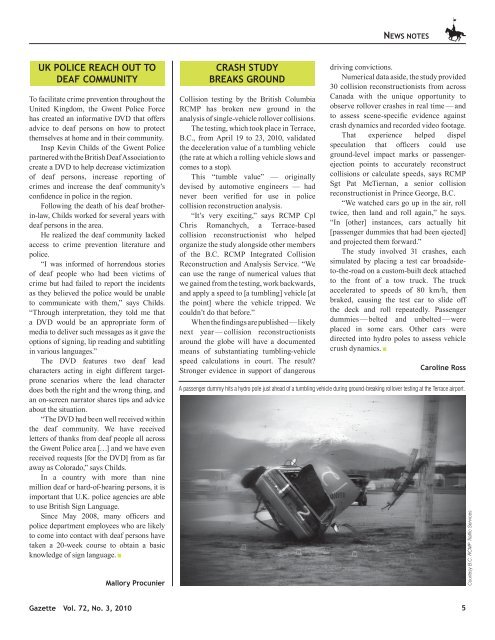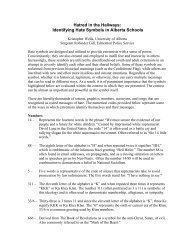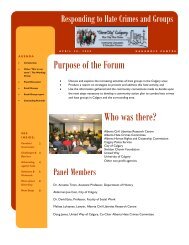RCMP Gazette Human Rights and Policing - Alberta Hate Crimes ...
RCMP Gazette Human Rights and Policing - Alberta Hate Crimes ...
RCMP Gazette Human Rights and Policing - Alberta Hate Crimes ...
Create successful ePaper yourself
Turn your PDF publications into a flip-book with our unique Google optimized e-Paper software.
NEWS NOTESuk POliCE REACh OuT TODEAF COMMuNiTyTo facilitate crime prevention throughout theUnited Kingdom, the Gwent Police Forcehas created an informative DVD that offersadvice to deaf persons on how to protectthemselves at home <strong>and</strong> in their community.Insp Kevin Childs of the Gwent Policepartnered with the British Deaf Association tocreate a DVD to help decrease victimizationof deaf persons, increase reporting ofcrimes <strong>and</strong> increase the deaf community’sconfidence in police in the region.Following the death of his deaf brotherin-law,Childs worked for several years withdeaf persons in the area.He realized the deaf community lackedaccess to crime prevention literature <strong>and</strong>police.“I was informed of horrendous storiesof deaf people who had been victims ofcrime but had failed to report the incidentsas they believed the police would be unableto communicate with them,” says Childs.“Through interpretation, they told me thata DVD would be an appropriate form ofmedia to deliver such messages as it gave theoptions of signing, lip reading <strong>and</strong> subtitlingin various languages.”The DVD features two deaf leadcharacters acting in eight different targetpronescenarios where the lead characterdoes both the right <strong>and</strong> the wrong thing, <strong>and</strong>an on-screen narrator shares tips <strong>and</strong> adviceabout the situation.“The DVD had been well received withinthe deaf community. We have receivedletters of thanks from deaf people all acrossthe Gwent Police area […] <strong>and</strong> we have evenreceived requests [for the DVD] from as faraway as Colorado,” says Childs.In a country with more than ninemillion deaf or hard-of-hearing persons, it isimportant that U.K. police agencies are ableto use British Sign Language.Since May 2008, many officers <strong>and</strong>police department employees who are likelyto come into contact with deaf persons havetaken a 20-week course to obtain a basicknowledge of sign language. ▪Mallory ProcunierCRASh STuDybREAkS GROuNDCollision testing by the British Columbia<strong>RCMP</strong> has broken new ground in theanalysis of single-vehicle rollover collisions.The testing, which took place in Terrace,B.C., from April 19 to 23, 2010, validatedthe deceleration value of a tumbling vehicle(the rate at which a rolling vehicle slows <strong>and</strong>comes to a stop).This “tumble value” — originallydevised by automotive engineers — hadnever been verified for use in policecollision reconstruction analysis.“It’s very exciting,” says <strong>RCMP</strong> CplChris Romanchych, a Terrace-basedcollision reconstructionist who helpedorganize the study alongside other membersof the B.C. <strong>RCMP</strong> Integrated CollisionReconstruction <strong>and</strong> Analysis Service. “Wecan use the range of numerical values thatwe gained from the testing, work backwards,<strong>and</strong> apply a speed to [a tumbling] vehicle [atthe point] where the vehicle tripped. Wecouldn’t do that before.”When the findings are published — likelynext year — collision reconstructionistsaround the globe will have a documentedmeans of substantiating tumbling-vehiclespeed calculations in court. The result?Stronger evidence in support of dangerousdriving convictions.Numerical data aside, the study provided30 collision reconstructionists from acrossCanada with the unique opportunity toobserve rollover crashes in real time — <strong>and</strong>to assess scene-specific evidence againstcrash dynamics <strong>and</strong> recorded video footage.That experience helped dispelspeculation that officers could useground-level impact marks or passengerejectionpoints to accurately reconstructcollisions or calculate speeds, says <strong>RCMP</strong>Sgt Pat McTiernan, a senior collisionreconstructionist in Prince George, B.C.“We watched cars go up in the air, rolltwice, then l<strong>and</strong> <strong>and</strong> roll again,” he says.“In [other] instances, cars actually hit[passenger dummies that had been ejected]<strong>and</strong> projected them forward.”The study involved 31 crashes, eachsimulated by placing a test car broadsideto-the-roadon a custom-built deck attachedto the front of a tow truck. The truckaccelerated to speeds of 80 km/h, thenbraked, causing the test car to slide offthe deck <strong>and</strong> roll repeatedly. Passengerdummies — belted <strong>and</strong> unbelted —wereplaced in some cars. Other cars weredirected into hydro poles to assess vehiclecrush dynamics. ▪Caroline RossA passenger dummy hits a hydro pole just ahead of a tumbling vehicle during ground-breaking rollover testing at the Terrace airport.Courtesy B.C. <strong>RCMP</strong> Traffic Services<strong>Gazette</strong> Vol. 72, No. 3, 2010 5







